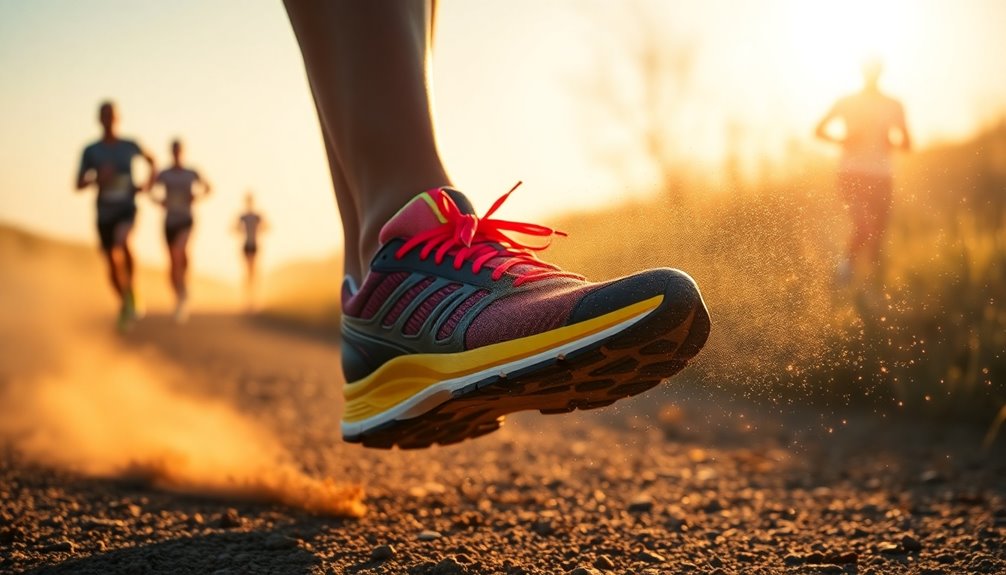The debate over foot strike patterns, particularly between rearfoot strike (RFS) and forefoot strike (FFS), is reshaping running science. While 71% of marathon runners use RFS, it can increase injury risk due to high vertical loading rates. FFS may reduce this risk but can also introduce new stresses. Transitioning safely between these styles demands a thoughtful approach, considering running mechanics and footwear. Keep exploring to discover more about how these patterns impact your running performance.
Key Takeaways
- The debate between rearfoot strike (RFS) and forefoot strike (FFS) challenges established running science and their associated injury risks.
- RFS increases vertical loading rates, significantly raising the potential for knee and hip injuries compared to non-RFS techniques.
- Minimalist footwear promotes shifts to FFS, but transitioning too quickly can lead to new injuries if not approached gradually.
- Emphasizing running technique and form can improve efficiency and reduce injury risk, regardless of the foot strike pattern used.
- A deeper understanding of foot strike impacts encourages runners to make informed footwear choices to enhance performance and minimize injuries.

When you run, the way your foot strikes the ground can significantly affect your performance and injury risk. One common pattern is the rearfoot strike (RFS), where your heel makes initial contact with the ground. Studies show that around 71% of marathon runners stick to this pattern, even when switching to minimalist footwear. However, this choice mightn't be the best for everyone, especially concerning injury risk.
Runners who use the RFS pattern experience a vertical loading rate that's three times greater than those employing a non-RFS technique. This elevated loading can place excessive stress on your joints, particularly your knees and hips, potentially leading to injuries. If you're accustomed to traditional running shoes, you may find it challenging to shift your running mechanics. Even after two weeks of training in minimalist footwear, changes in kinematic variables, like an increase in knee flexion angle at initial contact, are minimal. This suggests that while your body can adapt somewhat, it may not significantly alter your foot strike pattern.
On the other hand, transitioning to barefoot-simulating shoes often encourages a movement toward a forefoot strike (FFS) pattern. This aligns more closely with natural barefoot running kinematics, which could reduce injury risk by promoting better alignment and mechanics. However, this transition isn't without its challenges. If you aren't careful, shifting to an FFS can place new stresses on different parts of your foot, which might lead to injuries if your body isn't adequately conditioned for these changes.
To ensure a safe transition, it's crucial to focus on your running technique. Pay attention to how you land and adjust your form accordingly. Gradual adaptation, rather than an abrupt switch, can help you develop a more efficient foot strike pattern, whether it's RFS or FFS. Listen to your body; if you feel pain, it might be a sign that your running mechanics need adjustment or that you're transitioning too quickly.
Ultimately, the debate over foot strike patterns has led many to reconsider traditional running science. While both RFS and FFS have their merits, understanding how your foot strike affects your running mechanics can help you make informed decisions. Whether you prefer minimalist footwear or are considering barefoot running, it's essential to approach changes thoughtfully to minimize injury risk and enhance your performance.
Conclusion
In conclusion, embracing a more nuanced understanding of foot strike patterns can revolutionize your running experience. As traditional beliefs fade, it's clear that what works for one may not work for another. By exploring different techniques and listening to your body, you'll find the best approach that suits your unique style. So, don't be afraid to experiment and adapt; the future of running science is all about personalizing your stride for optimal performance and comfort.









